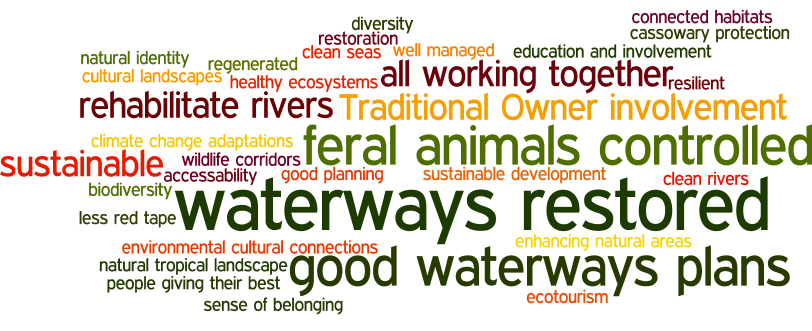
Our Local Landscape’s natural values and rural lifestyle are unique and special, and definitely worthy of our effort in managing and enhancing them.
Much of our Wet Tropics’ rainforests are protected in World Heritage Areas, providing refuge for many species of wildlife, as well as attracting tourists to our area.
Our rural and urban areas are equally valuable, supporting strong communities, diverse agriculture and contributing to our economy and sustainability. Our varied landscapes, from our coastal systems through to the mountain ranges, need our support to make sure they are as healthy as possible, now and into the future.
Our three top priorities
1. Biodiversity
We will protect our iconic wildlife species and the habitat they rely on, including building resilience against climate change.
Our local wildlife faces a range of risks, including habitat loss, fragmentation and degradation, impacts of roads, feral animals and climate change. By working collaboratively and using a whole of landscape approach, we can minimise threats and increase resilience in wildlife species and ecosystems.
We can leverage from a long history of successful community engagement and on-ground project activities to expand the scale and impact of habitat restoration work, improving ecological connectivity and the long term prospects for local plants and animals.
Our priority actions include:
- Promoting revegetation activities
- Protecting habitat, protecting cassowaries
- Minimising risks on wildlife from pets and invasive species
- Reducing the use and impact of chemicals in our environment
- Restoration work for biodiversity and climate outcomes
2. Water
We will protect and restore our waterways for the health of land and people.
Improving the health of our waterways through riparian restoration and on farm water treatment systems can lead to a healthier reef and an increase in recreational value, as well as supporting stronger social and cultural connections to our waterways.
Our priorities are:
- Increasing knowledge about best farm practices for natural in-ground water treatment
- Ongoing engagement with landholders to improve methods and cooperation.
3. Biosecurity
We will improve understanding and management of biosecurity risks to minimise damage to our natural systems and agricultural industries.
A comprehensive, collaborative and ongoing management program will minimise damage caused by feral pigs.
Examples of our priority actions include:
• Reduce feral pig numbers through collaborative management
• Incorporate local knowledge and increase understanding of management options to reduce impact on non-target species
Other priorities:
In addition to the priorities above, our community would also like to see progress on the following ideas:
Funding and Resources
To continue the good work happening in our local landscape, reliable, long-term funding is needed to build on the existing momentum of environmental work and allow for the implementation of priority NRM projects.